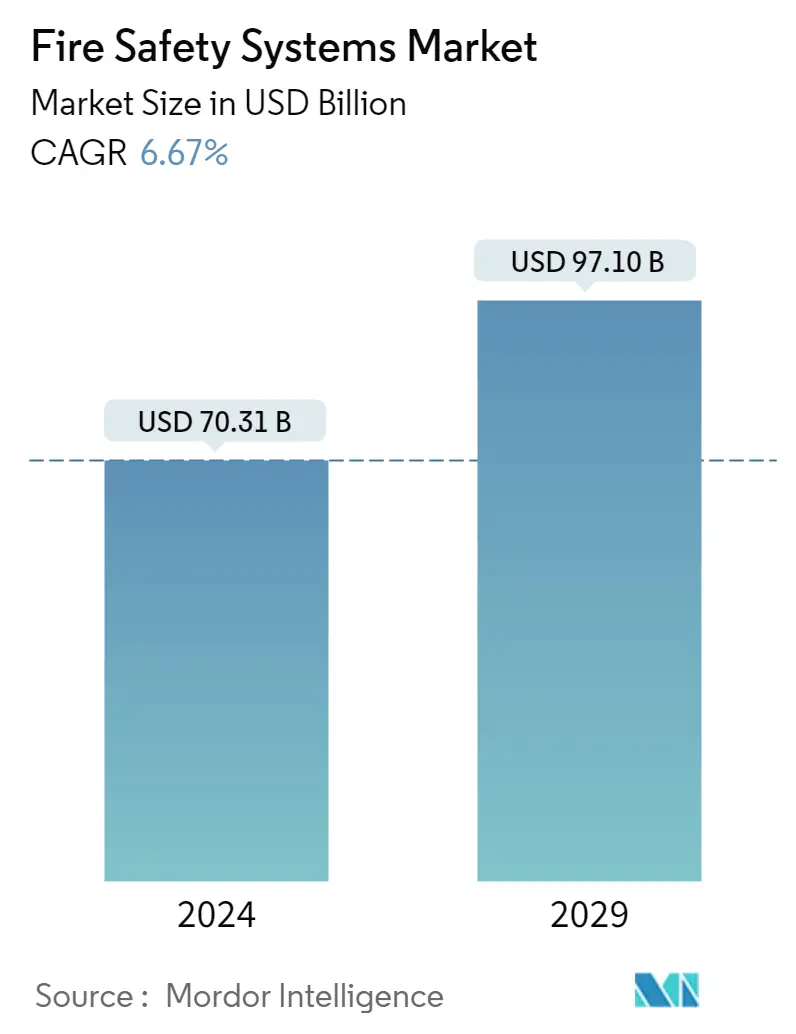Market Size of Fire Safety Systems Industry

| Study Period | 2019 - 2029 |
| Market Size (2024) | USD 70.31 Billion |
| Market Size (2029) | USD 97.10 Billion |
| CAGR (2024 - 2029) | 6.67 % |
| Fastest Growing Market | Asia-Pacific |
| Largest Market | North America |
| Market Concentration | Low |
Major Players
*Disclaimer: Major Players sorted in no particular order |
Fire Safety Systems Market Analysis
The Fire Safety Systems Market size is estimated at USD 70.31 billion in 2024, and is expected to reach USD 97.10 billion by 2029, growing at a CAGR of 6.67% during the forecast period (2024-2029).
The primary motivation for building alarm system requirements and fire codes is to provide early notification to the building occupants so that people can exit the building and notify the fire service. Rapid urbanization and industrialization are propelling the demand for fire safety systems. The rising awareness about fire safety is also anticipated to supplement the market's growth.
- The inadequacy of old systems or the incapability of fire and safety systems for the new, vertically growing real state has created the demand for new, improved systems. This allows fire system distributors, system integrators, and manufacturers to educate the public or the customer on more effective protection. Moreover, the expansion of the industrial and commercial sectors and the growing awareness of fire safety are expected to impact the business landscape positively.
- Further, the fire safety regulations across vast warehouses are also generating the demand for fire safety systems to combat the increasing threat and reduce fire risks in warehouses. The British Sprinkler Alliance (BSA) also found that warehouse fires cause a loss of USD 280 million to UK businesses every year and a further annual loss of USD 230 million in the impact on productivity and the supply chain.
- Installing fire protection systems is paramount to ensure people's safety in emergencies. Installation from buses to hospitals is necessary to save lives and injuries. Government authorities of several countries have been taking new initiatives and launching directives regarding implementation of fire protection systems at offices and buildings along with buses.
- According to the Indian Government, in February 2022, the need to install fire protection systems increased in school and passenger buses due to the rise in fire incidents. Government authorities have been taking various steps to realize the urgency of installing such systems.
- Companies in the market are increasingly moving toward the digitization approach in product innovations. For instance, Siemens AG adopted a Cerberus Portal, a cloud platform that allows control from mobile devices of all fire control panel information, such as faults, alarms, and general system status, to be accessed remotely. The company has estimated that with this application, the company will gain more than 10% of customers with the same number of staff.
- The COVID-19 pandemic lockdowns increased the risk of home fires. Since many people were at home, using more heating equipment, increased cooking and consumption of smoking materials resulted in home fire hazards, with the potential for death or/and injury. With the growing population in countries and the need to safeguard lives, the fire safety systems market is expected to witess a substantial growth in the post-pandemic years.
Fire Safety Systems Industry Segmentation
Fire-detection systems are used to detect both common fire hazards and special fire hazards in buildings as well as in factory premises. Various types of such systems are available, each designed to meet the customer's needs in different applications or building or fire types.
The Fire Safety Systems Market is segmented by Technology (Passive Fire Safety Systems, Active Fire Safety Systems), by Product (Fire Detector (Detectors, alarms), Fire Suppression (Gas, Foam, Other Fire Suppression Products)), by End-User (Commercial, Industrial, Government, Other End), and by Geography (North America (United States, Canada) Europe (United Kingdom, Germany, France, Rest of Europe) Asia-Pacific (China, Japan, India, Rest of Asia-Pacific), Latin America, Middle East and Africa).
The market sizes and forecasts are provided in terms of value (USD million) for all the above segments.
| By Technology | |
| Passive Fire Safety Systems | |
| Active Fire Safety Systems |
| By Product | |||||
| |||||
|
| By End-User | |
| Commercial | |
| Industrial | |
| Government | |
| Other End-Users |
| By Geography | ||||||
| ||||||
| ||||||
| ||||||
| Latin America | ||||||
| Middle East and Africa |
Fire Safety Systems Market Size Summary
The fire protection systems market is poised for significant growth, driven by rapid urbanization, industrialization, and heightened awareness of fire safety. The demand for advanced fire safety solutions is fueled by the inadequacy of outdated systems and the need for improved protection in vertically growing real estate. This has created opportunities for distributors, integrators, and manufacturers to educate customers on effective fire protection measures. The expansion of industrial and commercial sectors, along with stringent fire safety regulations, is expected to positively impact the market landscape. Government initiatives and directives across various countries further emphasize the importance of installing fire protection systems in buildings, vehicles, and public transport to enhance safety and reduce risks.
The market is characterized by competitive dynamics, with major players like Johnson Controls, Honeywell International Inc., and Siemens leading the charge in innovation and digitalization of fire safety solutions. The adoption of cloud-based platforms and digital services is transforming the approach to fire safety, enabling remote monitoring and management of systems. Regulatory frameworks, such as those set by OSHA and the National Fire Protection Act, mandate the installation and regular inspection of fire safety equipment, driving compliance and market growth. The Asia-Pacific region, particularly India and China, is expected to be a key growth driver due to rapid urban development and strong manufacturing capabilities. The market's expansion is further supported by strategic acquisitions and investments in advanced fire suppression technologies, ensuring a robust and secure environment across various sectors.
Fire Safety Systems Market Size - Table of Contents
-
1. MARKET INSIGHTS
-
1.1 Market Overview
-
1.2 Industry Attractiveness - Porter's Five Forces Analysis
-
1.2.1 Bargaining Power of Suppliers
-
1.2.2 Bargaining Power of Consumers
-
1.2.3 Threat of New Entrants
-
1.2.4 Threat of Substitutes
-
1.2.5 Intensity of Competitive Rivalry
-
-
1.3 Impact of COVID-19 on the Fire Safety Systems Market
-
-
2. MARKET SEGMENTATION
-
2.1 By Technology
-
2.1.1 Passive Fire Safety Systems
-
2.1.2 Active Fire Safety Systems
-
-
2.2 By Product
-
2.2.1 Fire Detector
-
2.2.1.1 Detectors
-
2.2.1.2 Alarms
-
-
2.2.2 Fire Suppression
-
2.2.2.1 Gas
-
2.2.2.2 Foam
-
2.2.2.3 Other Fire Suppression Products
-
-
-
2.3 By End-User
-
2.3.1 Commercial
-
2.3.2 Industrial
-
2.3.3 Government
-
2.3.4 Other End-Users
-
-
2.4 By Geography
-
2.4.1 North America
-
2.4.1.1 United States
-
2.4.1.2 Canada
-
-
2.4.2 Europe
-
2.4.2.1 United Kingdom
-
2.4.2.2 Germany
-
2.4.2.3 France
-
2.4.2.4 Rest of Europe
-
-
2.4.3 Asia-Pacific
-
2.4.3.1 China
-
2.4.3.2 Japan
-
2.4.3.3 India
-
2.4.3.4 Rest of Asia-Pacific
-
-
2.4.4 Latin America
-
2.4.5 Middle East and Africa
-
-
Fire Safety Systems Market Size FAQs
How big is the Fire Safety Systems Market?
The Fire Safety Systems Market size is expected to reach USD 70.31 billion in 2024 and grow at a CAGR of 6.67% to reach USD 97.10 billion by 2029.
What is the current Fire Safety Systems Market size?
In 2024, the Fire Safety Systems Market size is expected to reach USD 70.31 billion.

